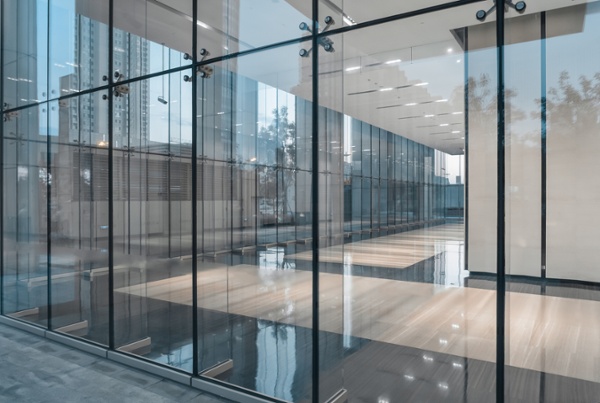
Have you ever stood in front of a recently cleaned window and didn’t realize it was there? Or maybe a glass table cover or custom shower enclosure?
If so, the glass was doing its job. As a material designed to provide a barrier with a clear view of the other side, glass takes on many functions. One type of commercial glass takes clarity above and beyond “appearing” almost invisible if properly maintained – low iron glass. Made to optimize light transmission and provide unobstructed viewing, low-iron glass delivers extreme transparency.
But what is low-iron glass?
What is Low Iron Glass: An Overview
Among the most transparent commercial glass types on the market, low-iron glass is as it sounds: glass with low iron content.
Made from materials naturally containing trace amounts of iron, low-iron glass boasts superior clarity. Comparing low-iron glass vs. regular clear glass, the former has about 90% less iron.
No matter a sheet’s thickness, low-iron glass maintains its clarity. Aside from a barely noticeable bluish tint along its edges, low-iron glass sheets are color-neutral.
Like other commercial glass types, low-iron glass is ready for additional fabrication, such as:
- Cutting
- Shaping
- Edgework/beveling
Low-iron glass also boasts the same strength as traditional glass. And like traditional glass, its durability and strength are enhanced through tempering, lamination, or chemical treatments.
The Science and Benefits of Low Iron Glass
What makes low-iron glass so clear? A lack of iron. Or more specifically, ferric oxide.
An inorganic compound, ferric oxide is a naturally occurring substance found in sand that’s used to create traditional clear glass.
Considered an impurity of sorts, ferric oxide is chemically reactive when heated up to extreme temperatures during the molting process. Its reaction to high heat and other substances used to create glass causes the ferric oxide to impart a greenish tint to the glass. The tint is more noticeable in thicker panes. In some projects, ferric oxide is added to molten glass to give the finished piece a more pronounced color.
Low-iron glass is made using silica sand (the kind found in your golf course’s sand trap), which naturally contains less iron.
Glass made with silica sand is clearer because the amount of ferric oxide present isn’t enough to impact its color through a chemical reaction. The superior transparency lends itself to two major benefits: improved light transparency and an almost colorless appearance.
Light Transmission
Low-iron glass doesn’t impede light passing through it, as it contains almost no impurities. Whether it’s used for commercial window glass or in a mirror, low-iron glass allows for maximum brightness up to 8% higher than traditional glass. While 8% may seem small, it makes a noticeable difference in the lighting brilliance of a space.
Tint
Made with a material containing a nominal amount of ferric oxide, low-iron glass maintains an almost colorless appearance. What little iron is in silica sand does cause low-iron glass pieces to have a subtle blue tint along their edges. Unlike the edges of thick pieces of standard glass -- which appear almost black in thicker sheets -- low iron glass edges only pick up the colors around them. For instance, if used in a shower enclosure with colored tiles, you may see notes of the tile color showing through the edges of a piece of low-iron glass.
Without a noticeable tint, low-iron glass does not compete with other colors in a space, blending in seamlessly.
Using Low Iron Glass in Commercial Glass Projects
Because its extreme clarity allows both light and colors to shine through unobstructed, low-iron glass is a popular choice across a wide variety of applications. One of its most common uses is in bathrooms, primarily for custom shower enclosures and mirrors.
Low-iron glass is ideal for:
- Display cases
- Glass walls
- Merchandising windows
- Doors
- Tabletop covers
- Furniture
- Entranceways
- Spandrels
- Balusters
- Cabinetry
- Aquariums
Inspecting Low Iron Glass: What to Look for
Like most glass products, low-iron glass is meant to be looked through.
When meeting with a low iron glass supplier, don’t be afraid to pick up a sample piece and look through it. When laying on top of a surface, such as a counter, low-iron glass edges can pick up the colors of what’s beneath it. The visible color transmission through the edges can give the wrong impression of a piece, making it appear tinted.
Properly inspecting the piece ensures you see a true representation of its clarity and virtual colorlessness.
Find a Low-Iron Glass Manufacturer
An ultra-clear material, low-iron glass takes glass transparency to the next level. Allowing for superior light transmission and unobstructed viewing, low-iron glass lets you get the most from the glass’s potential clarity.
Learn how easy it is to keep ShowerGuard UltraClear -- a low-iron glass product we carry -- looking as good as it did the day it was installed. (Chances are, you already have everything you need to maintain it).




